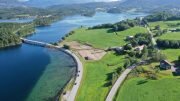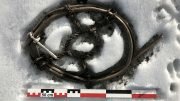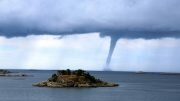“The ice is a time machine”, Dr. Lars Holger Pilø, one of the pioneers of Secrets of the Ice, tells us. The job of ice archeologists consists of braving some of Norway’s toughest terrains in search of ancient artifacts that have been hidden in – and preserved by – ice patches for hundreds or thousands of years.
Dr. Pilø notes, “There’s quite a lot of interest in our work. It’s sort of at the interface of exciting archeology and climate change.” And how could there not be?! Ice treasure hunting sounds like something straight out of an Arctic-infused Indiana Jones movie.
But in reality, though it is exciting, it’s much more than that. This is a scientific and academic pursuit that unravels the mysteries of human history, from the bygone times of the Stone Age, right through the Viking Age.
Trailblazing the world’s ice archeology field is the expert team at Secrets of the Ice who explore, make finds, and uncover the past in Norway’s Innlandet County.
Read on to discover firsthand what ice archeology is, what motivates a person to enter the field, and why the finds are so crucial – and compelling.
Meet one of the world’s leading ice archeologists, Dr. Lars Holger Pilø
Managing Secrets of the Ice are Lars Holger Pilø and Espen Finstad. We spoke to Dr. Pilø about their fascinating work; here’s the scoop.
Could you tell us a little bit about yourself and your background?
Dr. Pilø tells us, “I was born in Denmark, I’m Danish. I came to Norway in 1981. I did my PhD in archeology at the University of Oslo.
“Until the glacial archeology took off, I worked with settlement archeology in the lowlands.
“But, I’ve always had a strong interest in complex and difficult fieldwork. That’s sort of what triggers me.
“I got a chance to join the glacial archeology program in 2007, and I just basically dropped everything. I’ve been doing that ever since.”
What are some challenges of being an ice archeologist?
“I’m not sure about challenges. I like the complexity of the fieldwork.
“You have to plan things very meticulously ahead because once you’re up there if you don’t have all the necessary equipment, you’re stuck.
“Having the right equipment, the right people to do their specific job, and getting the work done in a professional manner is crucial. Our goal is always to rescue as many of the objects as we can when we’re up there.
“And then I like the unpredictability of it.
“In 2013, for example, we arrived at a mountain site. We got there late evening, set up the camp, and were ready for fieldwork the next morning.
“Until we got 20 centimeters of snow during the night, that is.
“I had realized that it had become very quiet during the night, and that’s not really a good sign… Then, I had to shovel my way out of the tent,” Dr. Pilø says, laughing.
He continues, “We just had to sit for three days in the tent, just drinking coffee and telling jokes and old stories. It eventually melted enough that we could start working on the lower parts of the site.”
“I enjoy it, it’s part of the experience.
“The landscape is also stunning. There’s a lot of wild reindeer roaming around up there.
“And then of course it’s nice to be up there with the team. It’s a lot of work, but we always share a lot of jokes, we have fun, and we make exciting discoveries.
“Sometimes we do fieldwork and we don’t make as many discoveries but still… You’ve been out there, you’ve been in the high mountains and among this fantastic scenery, having a great time.
“We had one official call for volunteers and, you can imagine, there’s a lot of people that applied.”
What motivated you to become an ice archeologist?
“This was a totally new field of archeology.
“So, the methods for surveying, the way to do the work in the fields, the set-up, the camps, and all that stuff that had not been developed. The chance of being part of that was it for me.
“Developing novel methods, doing this amazing work, that was what attracted me.
“And obviously the finds as well, because they are so special.
“The climate part, which has become more important to me later on, that was not part of it in the beginning. For me, it was the fact that it was a new field in archeology.”
Secrets of the Ice: A team effort
Who is involved in the Secrets of the Ice project?
“The Secrets of the Ice project is a collaboration.
“It’s between the Innlandet County Council’s Cultural Heritage Department, where I work, and the Museum of Cultural History in Oslo.
“So, we lead the project at our office and we do the fieldwork and the outreach, and the museum takes care of the finds.”
How big is the team at Secrets of the Ice?
“That depends. The Secrets of the Ice team can be either small or large depending on the situation.
“Normally, we have a small team consisting of core personnel who are part of the project. There are usually around four people.
“This is Espen and me, and team members Brit and Julian who take care of the arrows and other finds at the museum.
“In the summer, we have a larger team because we hire archeologists to come in and join us on the field so the field.
“We also have Reidar Marstein.”
The Secrets of the Ice “local hero of glacier archaeology“
“Our local person, Reidar Marstein, found the famous hide shoe [which effectively kicked off the Secrets of the Ice project] back in 2006.
“We consider him part of the team because he’s always out there helping us, scouting sites.
“He’s in his 70s now but he’s in much better shape than I have ever been”, Dr. Pilø laughs.
He continues, “I’ve been on some very heavy hikes with him and I’m normally totally broken.
“The thing is, is that it was not a coincidence that he found a shoe.
“Reidar is a local carpenter, a furniture carpenter in fact, but he’s always had a great interest in the past of the mountains.
“He knew that finds from the ice had been made across the border in the next county way back in the 30s, so he thought that there could be a chance out here, too.
“So, he started in the late 90s going to the ice every autumn when it was at the smallest and looking for finds. At this time, and he didn’t know that, but at this time the ice was quite large. This has to do with climate change in the 90s. So, he didn’t find anything at first.
“But, he didn’t give up, he went up again and again, and then in 2002, he made his first find. It was a scaring stick [a device used by hunters to lead reindeer towards hunters] at the neighboring site where he later found the shoe.
“Then in 2003, there was a big melt and he went back up again and he started finding arrows as well. In 2004 and 2005, there were extra snows, so he went up and there was nothing to see.
“And then in 2006, we had a really big melt. 2006 was an incredibly hot summer and autumn in Europe; it was a heatwave over large parts of the continent. Reidar went up in the mountains and found more arrows, and then he found the shoe.
“He said he immediately realized that this was something special.
“Of course he’d been in contact with us before but he took it down the mountain, I think he put it in his food box, and took it down, put it in his fridge, and the next morning he called Espen and said ‘I got something for you.’
“We initially thought that the shoe, if we were lucky, could be Viking Age.
“So we were stunned when it came back to be 3,400 years old!
“Now we know that the shoe fits a chronological pattern at this site, but at the time, this was a ‘Woah!’ find! It’s still a special one.”
Climate change and ice archeology
Where does climate change come in?
“Our finds are obviously related to the ongoing climate change, or global warming if you like. Everywhere in the world, mountain ice is retreating and it’s retreating quite fast. That’s why people make finds in places like northern North America and the Alps as well.
“The fact that artifacts are now melting out of the ice in our county in Norway is indeed a direct consequence of climate change. But, things are a little bit more complicated.
“We’ve had quite a number of climate discussions on social media, and so I’ve written a specific blog post on this which is called “Glacial archeology and global warming”, which addresses the issue.
“There are two misconceptions: that our finds can be used to say that global warming is not happening and that our finds are proof of global warming. Both of these are too simple.
“The finds are a consequence of global warming, but I don’t think we understand the finds in the sense that we should use them as proof of global warming.
“Ice patches are not like glaciers. Ice patches are more stationary, they’re smaller, and they react much more quickly to changes in weather and climate than the glaciers do. That means that they expand and contract much more frequently than glaciers.
“So, stuff that is lost in the snow on the ice patches is very likely to melt out even in the next decade after they were lost and then get washed downslope.
“Because if the case had been that they were in ice the whole time until now and only been exposed now due to global warming, everything would’ve been preserved perfectly, and it’s not. It’s melting out and washing out and continuously going in and out of the ice. So it’s quite complicated.
“On the other hand, people sometimes see that most of our finds are found on the ground and they think ‘But they were lost on the ground, so there was no ice here when they were lost, right?’ The thing is, the items that we find on the ground were not lost on the ground. They were first lost further up on the ice and they were washed down later.
“How could we disprove something as complex as climate science using archeological finds? It would be ridiculous.
“When you add all these greenhouse gases to the atmosphere, how will the Earth’s system react to that? The mechanisms are actually very well known. There’s just no scientific consensus at the moment to determine certainly that, if you, say, double the amount of CO2 in the atmosphere, then the temperature goes up by 1 degree, 2 degrees, 3 degrees or 4 degrees. This can’t be determined with certainty. Climate scientists use climate models, recent observations and palaeoclimate data from the Earth’s more distant past to estimate climate sensitivity.
“Obviously, since we don’t know the exact consequences, we should be really careful about global warming, instead of just going on with warming activities. It’s just not certain, I mean, things could go really wrong.”
Photos and photo information courtesy of Secrets of the Ice.
Source: Norway Today




Leave a comment